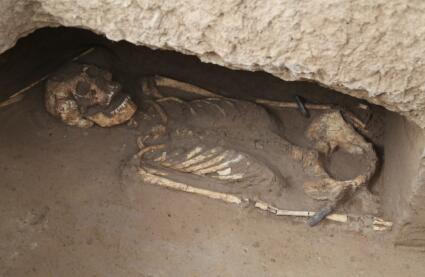Large-scale Cemetery of the Yangshao culture found in Yangguanzhai site, Shaan’xi
From:Chinese Archaeology NetWriter:Date:2018-04-11
Yangguanzhai site is a large central settlement of middle and late Yangshao Culture in central Shaanxi Area, which is located in Gaoling County, Shaan’xi province, approximately 25 kilometers north of the ancient city of Xi’an in northwest China. From 2015 to 2017, a large cemetery paralleling with surrounded moat of the settlement has been found during archaeological excavations of northeast section outside the settlement by Shaan’xi Provincial Institute of Archaeology, covering about 90,000 square meters in total. So far, about 3800 square meter has been uncovered. 336 prehistoric tombs have been confirmed and 172 of them have been cleared.
Aerial photo of the cemetery in Yangguanzhai Site
Tombs and Assemblage
Tombs excavated from this season are all small ones in rectangular plan. Tomb structures could be divided into two types, cave tombs and earthen shaft pit tombs. All tombs are east-west oriented. There are seemingly round post-hole remains in east or west ends of some tomb passages, being predicted to place banners (special flags used in ritual practices). It’s speculated that a very thorough and integrated plan was carried out in the construction processes of the cemetery.

Side-cave tombs M283

Tomb owner with bone hair-pin and stone ring
All tombs are single burials with relatively complete skeleton of the deceased. No wooden burial furniture has been unearthed yet. However, there were remains of textile fabrics seemingly being used to wrap up skeletons in some tombs. Tomb owners were all lying on their backs with outstretched limbs, heading the west. In some tombs, there were traces that finger bones were moved away. Some were found around skulls, and some were discovered in the filling soil. These seem to imply cutting-body burial ritual or unusual death. According to preliminary examination, inhabitants of the cemetery have close relationships with Eastern Asiatic Mongoloid. Most of the dead were middle-aged, and a few were infants and children. No senior people were found at all.

3D image of tomb M176
Relatively few burial gifts were uncovered from the tombs. There are only a few tombs having daily-used potteries, such as vases with pointed-base, painted pottery basins, painted pottery pots, sand-tempered jars, bo-bowls, cups and so on. Some skeletons even wore personal ornaments, like bone hairpins, stone rings or pottery rings, stone bi-rings, string of stone beads and bone beads and etc. Tools like jade axes were unearthed from some tombs, too. Besides, there were plenty of broken pottery vessels found in the joint of tomb passage and tomb chamber as well as in the filling soil. Moreover, pigments and turtle shells uncovered from some tombs are the earliest one found in the central Shaanxi plain.

Painted pottery pot(left) and pottery cup

Pottery bowl bo and painted pottery basin
Preliminary understanding and academic significance
According to burial gifts, C14 dates and related materials, we can predict that the cemetery should belong to Miaodigou period of Yangshao Culture. Thus, it’s the first large adult cemetery of Miaodigou period found in China so far. The excavation gave us the opportunity to gain a deeper insight into the settlement patterns and social structures of Yangguanzhai Site. Besides, side-cave tombs uncovered should be the earliest remains found ever before and bring emergence of this kind tombs 500 years earlier. They are precious archaeological materials for research on origins and spread of this kind of tombs as well as cultural exchanges and influences between the central Shaanxi plain and west China, and even the West world. (Translator: Ma Huanhuan Photograph:China Cultural Relics News )

